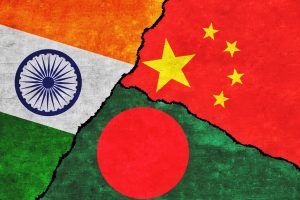Bangladesh Prime Minister Sheikh Hasina’s visit to China to Dhaka on July 8-10 was her fifth to that country and her first in five years. The China visit came close on the heels of her recent visits to India – the first on June 9 for Prime Minister Narendra Modi’s swearing-in and the second, just weeks later, an official bilateral visit.
The visits to China and India hold significant implications for Hasina’s foreign policy, economic strategy, and Bangladesh’s position in the geopolitical landscape. They highlight the challenges that Dhaka faces in balancing the competing interests of major global powers such as the United States, China, and India.
According to media reports, the main goal of Hasina’s China visit was to secure a $5 billion loan to bolster the Bangladeshi economy, which has been grappling with a foreign exchange crisis in recent years.
However, Hasina’s visit did not turn out as hoped. India News Network reported that her meeting with Chinese President Xi Jinping, including interpretation time, lasted only 30 minutes, indicating limited high-level engagement. Furthermore, Hasina was not accorded the customary protocol. No Chinese government ministers, including the foreign minister, called on her, highlighting a tepid bilateral interaction.
The visit was supposed to extend over four days but Hasina returned to Dhaka a day earlier, citing her daughter’s ill health. Media reports claimed that she shortened her visit due to dissatisfaction over Beijing’s failure to deliver promised financial support and provide the expected protocol during her visit.
The decision to cut short her visit suggests that her objectives for the trip were not met, Economic Times reported, citing unnamed sources familiar with the matter. Although Bangladesh sought a loan of $5 billion, China agreed to provide only 1 billion yuan or $140 million (at a press meeting after the visit, Hasina claimed that Beijing had agreed to give Bangladesh $2 billion).
In light of this shortfall, analysts have questioned the success of Hasina’s trip to China.
Importantly, it is unclear what form the Chinese loan will take. “We don’t yet know the proportions of commercial loans, concessional loans and interest-free loans, but I doubt they will be anything substantial. And for now, 1 billion yuan seems like a drop in the ocean of our massive economic needs,” said Md Touhid Hossain, former foreign secretary of Bangladesh, in an interview with The Business Standard, a Bangladeshi daily.
China’s objectives in Bangladesh are multifaceted, primarily focusing on reinforcing its strategic and economic influence in South Asia. By elevating their relationship to a comprehensive strategic cooperative partnership, China aims to deepen its involvement in regional infrastructure through the Belt and Road Initiative (BRI), which includes investments in transportation, energy projects, and industrial parks.
China has invested in several infrastructure projects in Bangladesh, including the Padma Bridge, the Payra Power Plant, and various road and railway projects. These have been pivotal in Bangladesh’s development trajectory over the last decade.
Such investment has strengthened the Sino-Bangladesh partnership and Chinese presence in Bangladesh. It has helped Beijing secure a foothold in a strategically significant location between Myanmar and India. It allows for an expansion of Chinese geopolitical influence.
During Hasina’s visit, the two sides signed 21 instruments, including two renewed Memorandums of Understanding (MoUs) and seven more projects to elevate the bilateral relationship to a “comprehensive strategic cooperative partnership” from “strategic partnership.”
Both countries also promised to fight against external interference. This comes in the context of the United States and other Western powers trying to interfere in Bangladesh’s domestic affairs. In the run-up to the general elections early this year, the U.S. issued statements calling for a free and fair election and imposed sanctions on several Bangladeshi government officials for human rights violations and corruption.
Hasina also reaffirmed Bangladesh’s position on Taiwan. “Bangladesh firmly upholds the one-China principle and supports China’s stance on Taiwan,” she said.
Hasina’s visit to India on June 21-22 focused on enhancing trade, connectivity, and security cooperation. The two sides signed a rail connectivity agreement that will allow India to use Bangladesh’s rail network to transport goods to its Northeast. India has also agreed to extend transit facilities to Nepal and Bhutan for Bangladeshi goods through its railway networks.
The Teesta River water-sharing issue has been a longstanding point of contention between Bangladesh and India. A final agreement on sharing the waters of this river remains elusive.
Meanwhile, Dhaka plans to build a reservoir on the Teesta, a project that China is keen to finance, which has triggered concern in New Delhi, given its implications for India’s security. During Hasina’s visit to New Delhi, India announced it would send a technical team to evaluate the Teesta water conservation and management project.
Ahead of her China visit, Hasina said she would choose India over China regarding the Teesta reservoir project, although China has made good progress on the project.
Hasina’s statement is likely to have had “a negative impact, as China may be somewhat dissatisfied with our decision,” Hossain said. China’s interest in participating in the Teesta project stems from its broader regional strategy to step up economic and infrastructure investments in neighboring countries like Nepal and Bhutan, which also share rivers with India and Bangladesh.
It is likely that the United States, which is keen to contain China’s expanding influence, would be monitoring these developments. It is a long-standing trade, investment, and development partner of Bangladesh.
Meanwhile, on June 10, Bangladesh joined the Colombo Security Conclave (CSC) as its fifth member. Established in 2020, CSC is an India-initiated security alliance to counterbalance China’s influence in the Indian Ocean region.
The juxtaposition of these visits illustrates Bangladesh’s strategic hedging, balancing the influence of China and India while safeguarding its national interests.
Hasina’s recent trips to China and India lay bare its efforts to diversify Bangladesh’s international partnerships while maintaining a strategic balance. The mixed outcomes from these visits, especially the setbacks on the Chinese front, indicate churning and even changing equations in its relations with its powerful neighbors.

































